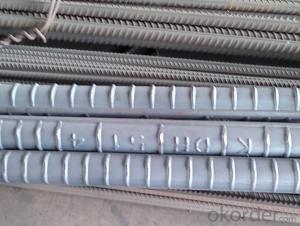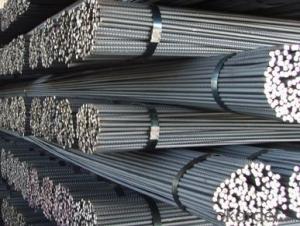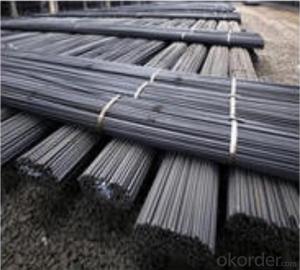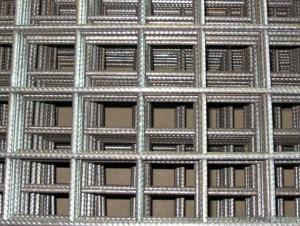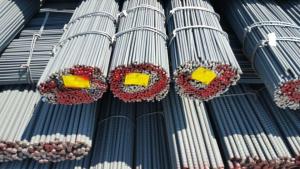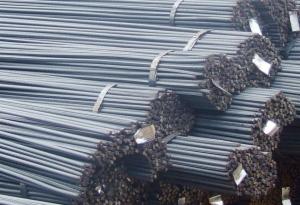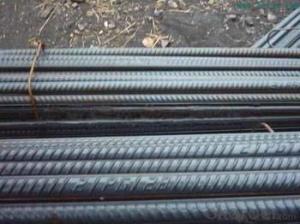Deformed steel bars type,Class IV Deformed Steel Bar with hige quality
- Loading Port:
- Tianjin
- Payment Terms:
- TT or LC
- Min Order Qty:
- 50 m.t.
- Supply Capability:
- 20000 m.t./month
OKorder Service Pledge
OKorder Financial Service
You Might Also Like
Product Description:
OKorder is offering Deformed steel bars type,Class IV Deformed Steel Bar with hige quality Building Material China Manufacturer at great prices with worldwide shipping. Our supplier is a world-class manufacturer of steel, with our products utilized the world over. OKorder annually supplies products to European, North American and Asian markets. We provide quotations within 24 hours of receiving an inquiry and guarantee competitive prices.
Product Applications:
Deformed steel bars type,Class IV Deformed Steel Bar with hige quality,Building Material China Manufacturer are ideal for structural applications and are widely used in the construction of buildings and bridges, and the manufacturing, petrochemical, and transportation industries.
Product Advantages:
OKorder's Deformed steel bars type,Class IV Deformed Steel Bar with hige quality,Building Material China Manufacturer are durable, strong, and resist corrosion.
Main Product Features:
· Premium quality
· Mill test certification
· Professional Service
· Competitive pricing
Product Specifications:
Product Name | Mark | Specification mm | Executive Standard | |||
Class IV Deformed Steel Bar | HRB400 | 6-32 | GB 1499.2-2007 | |||
Class V Deformed Steel Bar | HRB500 | 6-32 | GB 1499.2-2007 | |||
British Standard Thread | 460B B500B | 14-32 | BS4449:2005 | |||
Seismic Resistance Deformed Steel Bar | HRB400E HRB500E | 14-32 | GB 1499.2-2007 | |||
Anchor Bolt Steel | MG335 MG400 MG500 MG600 | 16-25 | Hot rolled ribbed bar for anchor bolt(exposure draft) | |||
MG335Y MG400Y MG500Y MG600Y | ||||||
FAQ
Q1: How do we guarantee the quality of our products?
A1: We have established an advanced quality management system which conducts strict quality tests at every step, from raw materials to the final product. At the same time, we provide extensive follow-up service assurances as required.
Q2: How soon can we receive the product after purchase?
A2: Within three days of placing an order, we will begin production. The specific shipping date is dependent upon international and government factors, but is typically 7 to 10 workdays.
Q3: What makes stainless steel stainless?
A3: Stainless steel must contain at least 10.5 % chromium. It is this element that reacts with the oxygen in the air to form a complex chrome-oxide surface layer that is invisible but strong enough to prevent further oxygen from "staining" (rusting) the surface. Higher levels of chromium and the addition of other alloying elements such as nickel and molybdenum enhance this surface layer and improve the corrosion resistance of the stainless material.
Images:
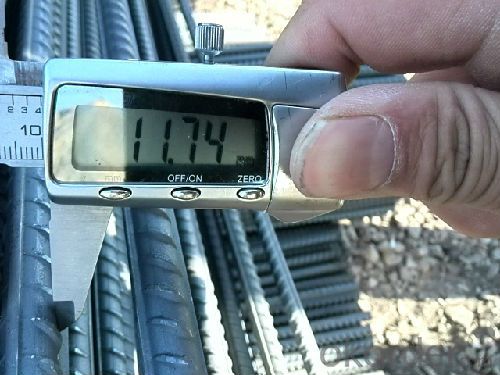
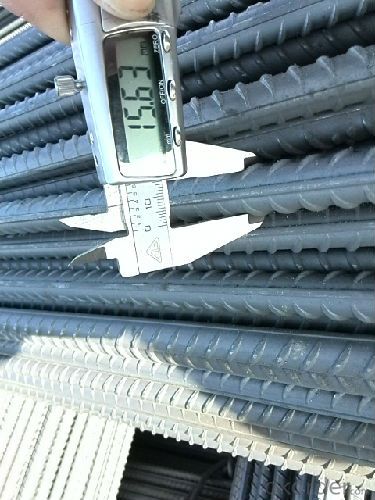
- Q: Are steel rebars easy to work with?
- Steel rebars can be both easy and challenging to work with, depending on the specific task and the individual's experience and skill level. In general, steel rebars are known for their strength and durability, making them a popular choice in construction projects. They are relatively easy to handle and manipulate due to their uniform shape and standardized sizes. However, working with steel rebars also requires certain precautions and techniques. Cutting and bending rebars can be physically demanding and may require specialized tools such as rebar cutters and benders. Additionally, the weight of rebars can be a challenge, especially when dealing with longer and thicker pieces. Furthermore, proper safety measures need to be followed when working with steel rebars. Wearing protective gear, such as gloves and goggles, is crucial to prevent injuries. Attention must also be paid to avoid any potential hazards, such as sharp edges and protruding rebars. Overall, while steel rebars can be relatively easy to work with for experienced professionals, they may present challenges for individuals with limited knowledge or tools. It is recommended to seek proper training and guidance when working with steel rebars to ensure safety and achieve precise results.
- Q: Are steel rebars suitable for use in high-temperature applications?
- Yes, steel rebars are generally suitable for use in high-temperature applications. Steel has excellent heat resistance properties and can withstand high temperatures without significant structural degradation. However, it is important to consider the specific requirements of the application and consult with experts to ensure the appropriate type of steel rebar is selected to meet the desired temperature resistance.
- Q: Can steel rebars be used in water storage tanks?
- No, steel rebars should not be used in water storage tanks as steel can corrode over time when exposed to water, leading to potential contamination of the water and compromising the structural integrity of the tank.
- Q: How do steel rebars affect the crack width in reinforced concrete?
- Steel rebars play a crucial role in controlling and minimizing the crack width in reinforced concrete structures. The primary function of steel rebars is to provide tensile strength to the concrete, as concrete alone is weak in tension. When a load is applied to the reinforced concrete, the steel rebars resist the tensile forces, preventing cracks from widening. The presence of steel rebars helps distribute the stress and strain more evenly throughout the concrete. As a result, the cracks that may occur due to external loads or shrinkage are confined and their width is limited. The rebars act as reinforcement, inhibiting the propagation of cracks and reducing their width. This is especially important in structural elements such as beams and columns, where crack control is critical for maintaining the integrity and durability of the structure. The diameter, spacing, and arrangement of the rebars also influence the crack width in reinforced concrete. Properly designed and placed rebars provide optimal crack control. As the diameter and spacing of the rebars decrease, the crack width decreases as well. Additionally, the arrangement of rebars in a specific pattern, such as using a mesh or a grid, can further enhance crack control by providing additional resistance to crack propagation. Moreover, the bond between steel rebars and concrete is essential in crack width control. Adequate bond strength ensures that the rebars effectively transfer stress to the concrete, limiting crack width. Insufficient bond can lead to slip between the steel rebars and the concrete, allowing cracks to widen. In summary, steel rebars significantly affect crack width in reinforced concrete by providing tensile strength, distributing stress and strain, confining cracks, and enhancing the bond between the steel and concrete. Proper design, placement, and arrangement of rebars are crucial for effective crack control, improving the overall performance and longevity of reinforced concrete structures.
- Q: How do steel rebars impact the durability of concrete structures?
- Steel rebars have a significant impact on the durability of concrete structures. The addition of steel rebars enhances the strength and overall performance of concrete, making it more resistant to various external forces and extending its lifespan. Firstly, steel rebars provide structural reinforcement to concrete structures. The tensile strength of concrete is relatively low, making it susceptible to cracking and failure under tensile stresses. By incorporating steel rebars into the concrete, these tensile stresses are effectively distributed throughout the structure, preventing cracks from forming and improving its overall load-bearing capacity. This reinforcement helps to ensure that the concrete structure can withstand the forces it is subjected to, whether it be from gravity, wind, earthquakes, or other external factors. Moreover, steel rebars also play a crucial role in preventing corrosion in concrete structures. Concrete is highly alkaline, which naturally provides a protective environment for embedded steel. However, over time, various factors such as exposure to moisture, chloride ions, and carbonation can lead to the breakdown of this protective layer, causing the steel to corrode. Corrosion not only weakens the rebars but also causes the surrounding concrete to crack and spall, compromising the durability of the structure. By using steel rebars with appropriate protective coatings or stainless steel, the risk of corrosion is significantly reduced, thus enhancing the longevity and durability of the concrete structure. Furthermore, steel rebars contribute to the durability of concrete structures by providing dimensional stability. Concrete tends to shrink and expand due to changes in temperature and moisture content, which can result in cracking and deformation. The inclusion of steel rebars helps to minimize these movements by providing restraint and stabilizing the structure, preventing excessive cracking and maintaining its integrity over time. In summary, steel rebars play a vital role in enhancing the durability of concrete structures. They provide structural reinforcement, prevent corrosion, and ensure dimensional stability. By incorporating steel rebars into concrete, structures become stronger, more resistant to external forces, and have an extended lifespan, ultimately leading to safer and more durable buildings and infrastructure.
- Q: How do steel rebars contribute to the strength of concrete?
- Steel rebars contribute to the strength of concrete by providing reinforcement and increasing its tensile strength. The rebars are embedded in the concrete, forming a strong bond between the two materials. This helps to distribute the load evenly and prevent cracks or fractures from forming, making the concrete structure more resistant to bending, shearing, and other external forces.
- Q: What are the different types of coating available for steel rebars?
- Steel rebars have a variety of coating options, each with its own unique qualities and advantages. Some commonly used coatings are: 1. Epoxy Coating: This coating is excellent at preventing corrosion and is often used in environments with moisture or harsh chemicals. It forms a protective barrier that extends the rebars' lifespan. 2. Zinc Coating: Also known as galvanization, this widely used coating offers excellent corrosion resistance. It acts as a sacrificial layer that corrodes before the rebars, preventing rust and increasing their longevity. 3. Polyethylene Coating: This thermoplastic coating is ideal for situations requiring electrical insulation. It is highly resistant to moisture, chemicals, and abrasion, making it suitable for various environments. 4. Fusion-Bonded Epoxy Coating: Applied through heat and pressure, this coating offers exceptional adhesion and corrosion resistance. It is particularly effective in harsh settings like marine or industrial applications. 5. Powder Coating: This dry finishing process involves applying a fine powder to the rebars and curing it in an oven. It creates a durable and protective coating that resists corrosion, chemicals, and UV radiation. With a wide range of available colors, powder coating is popular for decorative applications. These examples represent just a fraction of the coating options available for steel rebars. The choice of coating depends on specific project requirements, including environmental conditions, expected lifespan, and desired performance characteristics.
- Q: Can steel rebars be used in port infrastructure construction?
- Yes, steel rebars can be used in port infrastructure construction. Steel rebars are commonly used in the construction industry, including for port infrastructure projects. Rebars provide strength and reinforcement to concrete structures, making them ideal for constructing durable and resilient port facilities. They help in reinforcing concrete slabs, beams, and columns, ensuring that the structures can withstand the heavy loads and constant exposure to water and other environmental factors in port areas. Additionally, steel rebars have high tensile strength, making them suitable for handling the dynamic forces experienced in port infrastructure such as wharves, piers, and docks. Overall, steel rebars are an essential component in the construction of robust and long-lasting port facilities.
- Q: How do steel rebars resist fatigue and creep?
- Steel rebars resist fatigue and creep through their inherent material properties and proper design considerations. Fatigue refers to the gradual weakening of a material under repeated cyclic loading. Steel rebars are specifically designed to withstand fatigue by their high tensile strength and ductility. The tensile strength of steel allows it to resist the stress caused by cyclic loading, while its ductility allows it to deform without fracturing. This combination of properties enables steel rebars to endure numerous load cycles without failure. Additionally, steel rebars can be further enhanced to resist fatigue by employing various techniques such as heat treatment, surface coatings, and alloying. These methods improve the material's fatigue resistance and extend its service life under cyclic loading conditions. Creep, on the other hand, refers to the gradual deformation of a material under constant sustained loading. Steel rebars resist creep through their high stiffness and resistance to plastic deformation. The stiffness of steel allows it to maintain its shape and resist deformation under sustained loads. Moreover, the resistance to plastic deformation prevents excessive stretching or elongation, which can lead to creep failure. Proper design considerations also play a crucial role in enhancing the resistance of steel rebars to fatigue and creep. This includes ensuring appropriate reinforcement spacing, proper anchorage, and adequate concrete cover to protect the rebars from external factors that could induce fatigue or creep. In summary, steel rebars resist fatigue and creep due to their high tensile strength, ductility, stiffness, and resistance to plastic deformation. By utilizing proper design considerations and potentially implementing additional techniques, steel rebars can withstand cyclic loading and sustained loads for extended periods, ensuring their durability and structural integrity.
- Q: Can steel rebars be used in high-security facility construction?
- Indeed, high-security facility construction can incorporate steel rebars. With their strength and durability, steel rebars prove to be an appropriate choice for reinforcing concrete structures. In the case of high-security facilities, like prisons or government buildings, it becomes essential to ensure that the construction materials offer utmost strength and resistance against potential threats. By providing excellent tensile strength, steel rebars effectively reinforce concrete and enhance the overall structural integrity of the building. Moreover, the flexibility of steel rebars allows customization to meet the specific security requirements of the facility, such as employing thicker rebars or increasing their spacing to bolster reinforcement. Consequently, steel rebars are frequently employed in high-security facility construction, facilitating the establishment of a sturdy and safeguarded infrastructure.
Send your message to us
Deformed steel bars type,Class IV Deformed Steel Bar with hige quality
- Loading Port:
- Tianjin
- Payment Terms:
- TT or LC
- Min Order Qty:
- 50 m.t.
- Supply Capability:
- 20000 m.t./month
OKorder Service Pledge
OKorder Financial Service
Similar products
Hot products
Hot Searches
Related keywords

